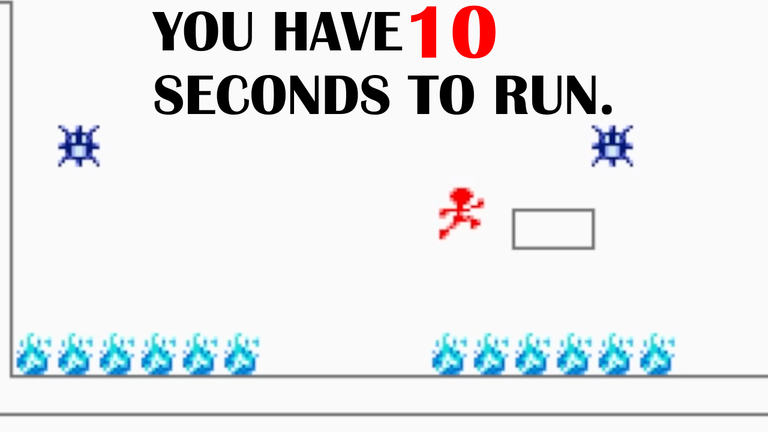

And I don't mean that only because of the simple looking visuals.
GO Series: 10 Second Run [the full name] is a game that was made for the DSiware, just like PiCTOBiTS, so it is a relatively small game compared to what you could get on proper DS cartridges.
I say that it feels straight out of what you could find in websites with Flash games because of the difficulty. It IS simple, but that simplicity is what can make you feel like you have the rug pulled under you repeatedly when you keep going - something that feels ironic when you think again about this being a digital-only game for the Nintendo DSi.
The title isn't an hyperbole, at least not in the main Trial mode: In that mode, you have exactly 10 seconds to get to the goal, and there are 50 levels in total.
The first half of levels range from easy enough that you can beat them in 5 seconds, to starting to ask for some more robust platfomer muscle memory with the jumps you have to hit. But when you get to the second half of stages, you'll soon notice how cheeky it becomes with the way blocks are placed - forcing you to be pretty precise to do certain jumps and land on safe ground without hitting hazards.
Before I talk about why that second half can be infurating though, let's go step by step over the quirks of this game.
The rules of the run
- Moving: Your character runs left or right at a fixed speed. No run button, no sliding around if you turn around, no ramp-up in acceleration if you start moving from a standstill. Very simple, but might be odd for people used to more elaborate platformers.
- Jumping: Your jump has a maximum height, but like in most platformers, you can let go of the button early for shorter jumps. This will be important.
- Timer: When I say you have exactly 10 seconds, it means EXACTLY 10 seconds. If the timer on the bottom hits 0.00, you're dead. But, if you can get to the goal in, say, 0.07 seconds...then that's fair game.
- Hazards: Aside from bottomless pits, the game will eventually throw moving enemies and stationary fireballs in levels. Touch one and you die. Simple, right?
- Vanishing Blocks: Oh, yeah, later on you'll also find blocks that vanish soon after you land on them. Get used to those.
Got all of that? Good, because now I'm going to talk about how these things come together in levels to go from basic challenges to locking you with endless attempts in, once again, 10 second levels.
Starting to feel the pressure
Aside from an extremely stupid slip up in Course 4 as they introduce the flame blocks there and ran into one, I was cruising through all the starting levels with ease as to be expected.
Course 11 begins with the second layer of hijinks as it introduces the spiky enemies, which move and...also kill you in one touch. Course 14 is the first one where it uses one of these to force you to move fast out of a block near the end, as otherwise the spiky enemy that moves over it will kill you.
This is increased with Course 15 where you have to do some jumps at the right time in order to avoid landing over the inconveniently placed moving things. And then Course 16 introduces moving blocks.
The first level for me where everything was put together to kick you in the legs would be in Course 19: Jumps over fire blocks, having to land over a moving block that's on top of a row of them, and a jump where a spiky enemy tries to block your landing.
And then the first level where the fire blocks are used in a NASTY way is at Course 27. I checked my footage and saw it took me 7 minutes of attempts...which might not sound much like first, but it can feel maddening when each attempt has to be a maximum of 10 seconds, so that adds up to quite many deaths had into the stage that bother you more and more due to the nature of the stage itself.
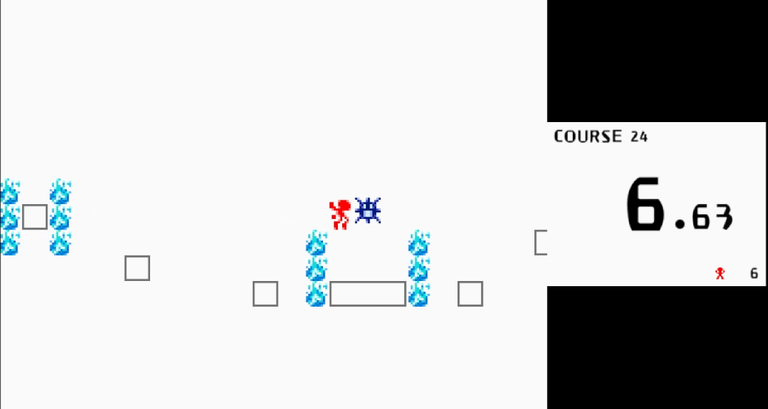
You gotta hit at least THREE one-wide jumps, squeezing into the space between the flame blocks and the spiky enemy on the first half - and that platform can be a chokepoint with how you have to not only land there without touching either, but also move to the right just enough to jump close to the right wall but not touching the wall or the spike enemy.
That took me a lot of attempts.
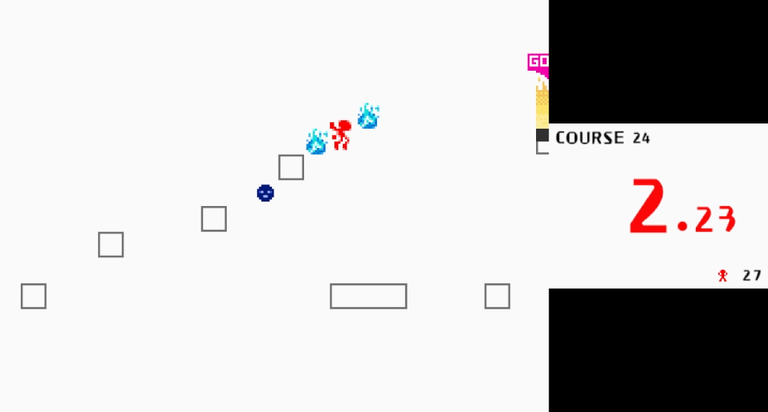
And after that seven minute grind that felt eternal, I just BARELY managed to get to the end.
Just look at the timer.
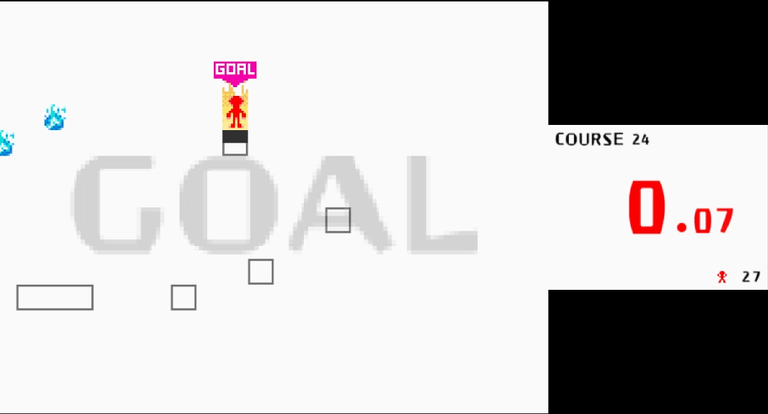
And now, its time to highlight a few of the stages from Course 30+ onwards and their own tricks up their sleeves.
Moving blocks and fiery death everywhere
Courses from 30 to 40 are MEAN. If you thought that those fire blocks could be annoying, then try for size levels that revolve around dodging a bunch of them.
For example, the following screenshot of Course 34 might not seem intimidating if you are confident in your jumps...but most of those platforms are moving - so you actually have to time very well your jumps [both in height and time] if you don't want to completely miss the needed landing.
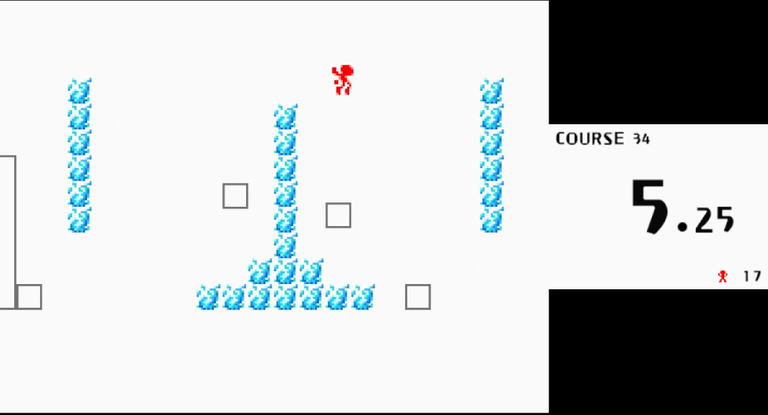
Course 37 forces you to pay attention to the moving blocks and timing to ride all of those into the finish line...because if you don't, you'll either miss out on valuable time to get to the goal, or run into a fire block. One of many.
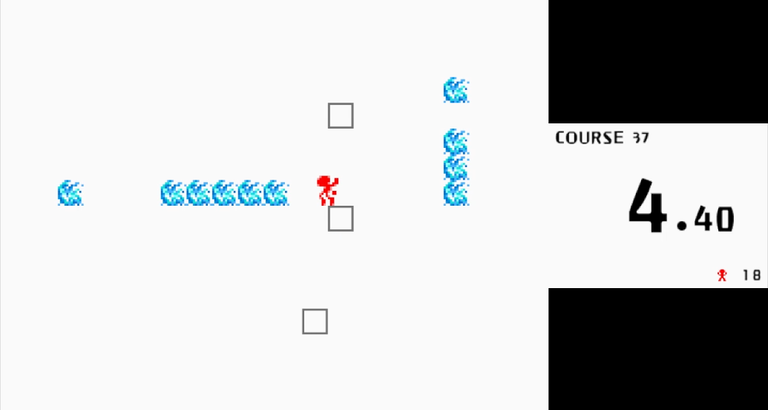
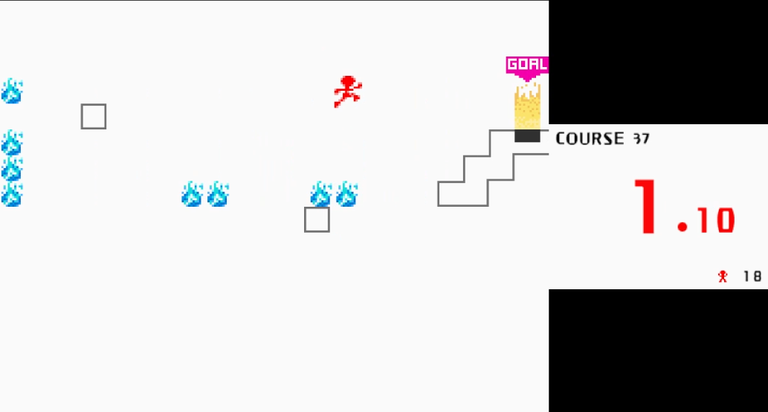
Course 38 throws you some precise jumps between fire walls, which might end up being kind of natural to do when you spend enough time, but you'll also run into these enemies that move in X shape and thus you'll need to wait or hope you arrived in the perfect time to run through them.
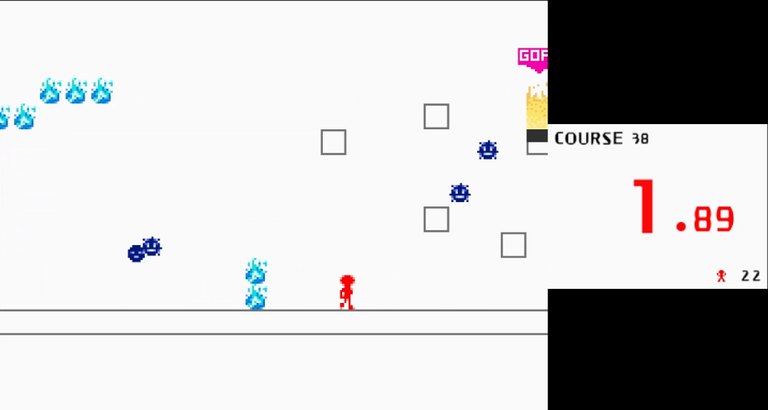
You have to do several jumps where you have to squeeze just right between two of those- Overshoot, undershoot or even move a bit too far to a fire wall after you've already made the jump...and you gotta try again.
And then Course 40 involves a very minimal looking level: The only thing you have to get across is a line of devilishly spaced out moving blocks. As they go left and right, you have to time your jump to when they are close enough to each other...and also be close enough to the edge of the block where you are to make the jump.
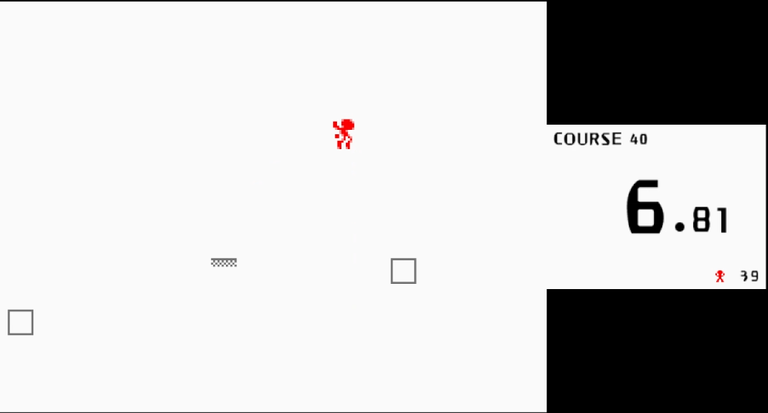
It is indeed a simple level in theory, but it is a real patience drainer in execution because of that very fact. No fireballs or vanishing blocks to pressure you, just some stupid precision jumps you have to hit while already being at a 10 second limit.
And what's next?
...As of writing this, I can't tell you yet what's next. I CAN guess that the final 10 levels will be as grind-inducing as those last 10 levels I played, but I haven't tried them yet nor even wanted to peek into the stage previews for them just to keep that fresh for when I do.
But at the end of the day, what you see is what you get: Fifty levels of quick platforming that soon ramp up into surprising precision and a lot of patience-squeezing jumps you have to hit.
This is not even touching the Marathon mode, which seems to put the fifty stages in five sets each, that while grant you infinite retries, it does force you to do at least ten level straight until you get them all done or give up halfway through. And the Training mode is playing all the stages you wish without the time limit - but that won't make any devilish tricks of them any easier to clear...it will just allow you to stop for a second if you need to strategize how to proceed forward.
Good luck getting to move on with the actual Trial stages if you rely too much on the extra time the Training mode gives you though.
In any case, certainly a little surprising game that's stowed away on the DSi and forced me to figure out how to load DSi games on Bizhawk just to grab a few Retroachievements on it [too bad I didn't figure that earlier for PiCTOBiTS]. But unlike PiCTOBiTS...this game actually got a sequel on the Nintendo Switch.
It might not be THIS exact game...but if you want something close to this but in a legitimately obtainable format [since just like every other DSiWare, this game's avaliability died with the DSi and 3DS virtual shops] as well as looking more modern and with more gimmicks to play with, then you should definitely give that one a look if this one interested you.
But if you don't have the budget [as in, a Nintendo Switch] or want to play this one with your own hands, then you already know that some research on emulating DSi games to get this running [or getting a modded DSi/3DS to stuff this there instead] can help you on that regard.
If you are curious to see in motion the first journey from 1 to 40, check out the video below - mostly timestamped for convenience in what set of stages are played...and starting from 35 onwards, separating the failed attempts and the actual victories into their own for quick refrence.
Thanks for reading!!!

Spanish translation with DeepL. All screenshots were captured by myself.
Español
GO Series: 10 Second Run [nombre completo] se siente como un juego hecho para esos sitios web con juegos de Flash Player.
Y no lo digo sólo por su aspecto visual sencillo.
Se trata de un juego creado para DSiware, al igual que PICTOBiTS, por lo que es relativamente pequeño en comparación con los cartuchos de DS.
Digo que parece sacado directamente de lo que podrías encontrar en páginas web con juegos Flash por su dificultad. ES sencillo, pero esa sencillez es la que puede hacerte sentir como si te tiraran de la manta repetidamente cuando sigues avanzando, algo que resulta irónico cuando vuelves a pensar en que se trata de un juego solo digital para la Nintendo DSi.
El título no es una hipérbole, al menos no en el modo Trial principal: En ese modo, tienes exactamente 10 segundos para llegar a la meta, y hay 50 niveles en total.
La primera mitad de los niveles oscila entre lo suficientemente fácil como para que puedas superarlos en 5 segundos, y lo que empieza a pedir algo más de memoria muscular platfomer con los saltos que tienes que pegar. Pero cuando llegues a la segunda mitad de las fases, pronto te darás cuenta de lo descarada que se vuelve la forma de colocar los bloques, obligándote a ser bastante preciso para realizar ciertos saltos y aterrizar en terreno seguro sin chocar con los peligros.
Pero antes de hablar de por qué esa segunda mitad puede ser infumable, repasemos paso a paso las peculiaridades de este juego.
Las reglas de la carrera
- Movimiento: Tu personaje corre a izquierda o derecha a una velocidad fija. Sin botón de correr, sin deslizarte si te das la vuelta, sin acelerar si empiezas a moverte desde parado. Muy sencillo, pero puede resultar extraño para gente acostumbrada a juegos de plataformas más elaborados.
- Salto: Tu salto tiene una altura máxima, pero como en la mayoría de plataformas, puedes soltar el botón antes para saltos más cortos. *Esto será importante.
- Temporizador: Cuando digo que tienes exactamente 10 segundos, significa EXACTAMENTE 10 segundos. Si el temporizador en la parte inferior llega a 0.00, estás muerto. Pero si puedes llegar a la meta en, digamos, 0,07 segundos... entonces es un juego justo.
- Peligros: Aparte de los pozos sin fondo, el juego eventualmente lanzará enemigos en movimiento y bolas de fuego estacionarias en los niveles. Si tocas una, mueres. *Sencillo, ¿verdad?
- Bloques evanescentes: Sí, más adelante también encontrarás bloques que desaparecen poco después de que aterrices sobre ellos. Acostúmbrate a ellos.
¿Lo has entendido todo? Bien, porque ahora voy a hablar de cómo estas cosas se juntan en los niveles para pasar de retos básicos a bloquearte con intentos interminables en, una vez más, niveles de 10 segundos.
Empezando a sentir la presión
Aparte de un desliz extremadamente estúpido en el nivel 4, cuando introdujeron los bloques de llamas y me topé con uno, pasé todos los niveles iniciales con facilidad, como era de esperar.
El nivel 11 comienza con la segunda capa de travesuras al introducir los enemigos con pinchos, que se mueven y... también te matan con un solo toque. El recorrido 14 es el primero en el que utiliza uno de estos para obligarte a salir rápidamente de un bloque cerca del final, ya que de lo contrario el enemigo con pinchos que se mueve sobre él te matará.
Esto se incrementa con el Recorrido 15, en el que tienes que dar algunos saltos en el momento adecuado para evitar aterrizar sobre las cosas móviles incómodamente colocadas. Y luego el Campo 16 introduce los bloques móviles.
Para mí, el primer nivel en el que todo se juntó para darte una patada en las piernas fue en el Recorrido 19: saltos sobre bloques de fuego, tener que aterrizar sobre un bloque móvil que está encima de una fila de ellos, y un salto en el que un enemigo con pinchos intenta bloquear tu aterrizaje.
Y el primer nivel en el que los bloques de fuego se usan de una manera NARDA es en el recorrido 27. Revisé mis grabaciones y vi que me llevó 7 minutos de intentos... lo cual puede no parecer mucho para empezar, pero puede resultar enloquecedor cuando cada intento tiene que ser de un máximo de 10 segundos, así que eso suma bastantes muertes dentro de la fase que te molestan cada vez más debido a la naturaleza de la fase en sí.

Tienes que pegar al menos TRES saltos de un ancho, apretándote en el espacio entre los bloques de llamas y el enemigo de pinchos en la primera mitad - y esa plataforma puede ser un punto de estrangulamiento por cómo tienes que no sólo aterrizar allí sin tocar ninguno de los dos, sino también moverte a la derecha lo suficiente para saltar cerca de la pared derecha pero sin tocar la pared ni al enemigo de pinchos.
Eso me llevó muchos intentos.

Y después de esos siete minutos que se me hicieron eternos, apenas POR LOS PELOS conseguí llegar al final.
Mira el temporizador.

Y ahora, ha llegado el momento de destacar algunas de las fases a partir del curso 30+ y sus propios trucos bajo la manga.
Bloques móviles y muerte ardiente por todas partes
Los niveles de 30 a 40 son MALVADOS. Si pensabas que esos bloques de fuego podían ser molestos, entonces prueba niveles de tamaño que giren en torno a esquivar un montón de ellos.
Por ejemplo, la siguiente captura de pantalla del recorrido 34 puede no parecer intimidante si tienes confianza en tus saltos... pero la mayoría de esas plataformas se mueven, así que tienes que calcular muy bien tus saltos [tanto en altura como en tiempo] si no quieres perder por completo el aterrizaje necesario.

El recorrido 37 te obliga a prestar atención a los bloques móviles y a calcular el tiempo para llegar a la meta... porque si no, perderás un tiempo valioso para llegar a la meta o te toparás con un bloque de fuego. Uno de tantos.


El recorrido 38 te lanza algunos saltos precisos entre muros de fuego, que pueden acabar siendo algo natural de hacer cuando pasas el tiempo suficiente, pero también te toparás con estos enemigos que se mueven en forma de X y por lo tanto tendrás que esperar o desear haber llegado en el momento perfecto para correr a través de ellos.

Tienes que hacer varios saltos en los que te tienes que apretar justo entre dos de esos. Te pasas, te quedas corto o incluso te acercas demasiado a una pared de fuego cuando ya has hecho el salto... y tienes que volver a intentarlo.
El recorrido 40 es un nivel de aspecto muy minimalista: Lo único que tienes que atravesar es una línea de bloques móviles endiabladamente espaciados. A medida que se mueven a izquierda y derecha, tienes que sincronizar tu salto para cuando estén lo suficientemente cerca el uno del otro... y también estar lo suficientemente cerca del borde del bloque donde tienes que hacer el salto.

En teoría es un nivel sencillo, pero en la práctica es un auténtico sumidero de paciencia. No hay bolas de fuego ni bloques que desaparecen que te presionen, sólo unos estúpidos saltos de precisión que tienes que dar estando ya en un límite de 10 segundos.
¿Y ahora qué?
...En el momento de escribir esto, aún no puedo decirte qué es lo siguiente. PUEDO suponer que los 10 últimos niveles serán tan agotadores como los 10 últimos a los que he jugado, pero aún no los he probado, ni siquiera he querido echar un vistazo a los avances de las fases para tenerlo fresco para cuando lo haga.
Pero al fin y al cabo, lo que ves es lo que hay: Cincuenta niveles de plataformas rápidas que pronto se convierten en una precisión sorprendente y un montón de saltos que hay que superar con paciencia.
Esto sin mencionar el modo Maratón, que parece dividir las cincuenta fases en cinco grupos cada uno, que si bien te conceden reintentos infinitos, te obligan a hacer al menos diez niveles seguidos hasta que los acabes todos o te rindas a mitad de camino. Y el modo Entrenamiento consiste en jugar todas las fases que quieras sin límite de tiempo - pero eso no hará que sea más fácil superarlas... sólo te permitirá parar un segundo si necesitas elaborar una estrategia para seguir adelante.
No obstante, si confías demasiado en el tiempo extra que te da el modo Entrenamiento, no tendrás mucha suerte a la hora de pasar a las fases de prueba.
En cualquier caso, no deja de ser un juego sorprendente que se ha guardado en la DSi y que me ha obligado a averiguar cómo cargar juegos de DSi en Bizhawk sólo para conseguir unos cuantos Retroachievements [lástima que no lo descubriera antes para PiCTOBiTS]. Pero a diferencia de PiCTOBiTS... este juego tiene una secuela en Nintendo Switch..
Puede que no sea ESTE juego exacto... pero si quieres algo parecido a esto pero en un formato legítimamente obtenible [ya que al igual que el resto de DSiWare, la disponibilidad de este juego murió con las tiendas virtuales de DSi y 3DS], así como con un aspecto más moderno y con más trucos para jugar, entonces definitivamente deberías echarle un vistazo si este te interesó.
Pero si no tienes el presupuesto [es decir, una Nintendo Switch] o quieres jugar a esta versión que yo probé con tus propias manos, entonces ya sabes que algo de investigación sobre la emulación de juegos de DSi para conseguir que esto funcione [o conseguir una DSi/3DS modificada para rellenar esto allí en su lugar] puede ayudarte en ese sentido.
Si tienes curiosidad por ver en movimiento el primer viaje de 1 a 40, echa un vistazo al vídeo a continuación - en su mayoría timestamped por conveniencia en qué conjunto de etapas se juegan ... y a partir de 35 en adelante, separando los intentos fallidos y las victorias reales en su propio para refrence rápida.
¡Gracias por leer!

Traducción al español hecha con DeepL. Todas las fotos capturadas por mí.
Simple but challenging, especially the later levels. I saw those failed attempts of level 37, clutch clear at 0.07 seconds left too.
And I'm still thinking about how the final 10 levels gonna be...I was revisiting the game at the time I was writing this to double check on the extra modes but also to get the game's cheevos [as the first time I played it, I wasn't getting those due to the emu choice].
Going through some of the toughest will be a rough feeling knowing how long those took me the first time, but I guess that at least if I redo all of those again and then do the final levels, at least I will have the cheevos for clearing those registered [in Hardcore mode - which means no savestates or rewind used].
Thanks for reading and for your comment :]
Demasiados clasicos excelentes tiene la DSi, creo que incluso hoy esta muy vigente junto con la 3DS
Si tienes una 3DS, afortunadamente podrías meterle todos esos juegos de DSi que andan sueltos por ahi si la tienes modeada...ya que hoy en día para conseguir esos juegos digitales tanto de DSi como de 3DS, ya no queda de otra.
La verdad creo que PiCTOBiTS y este juego son los que más me llamaron la atención de los DSiWare, quitando que también recuerdo Flipnote Studio [una leyenda, pero no es un juego como tal?], Dr. Mario Express [mira que primero tendría que hablar del Dr. Mario original jajajaj] y Photo Dojo que ese si no se como haría para emularlo ya que el chiste era tomarte fotos para hacer de personaje en un juego de pelea.
Pero si que diría que al menos con PiCTOBiTS y las cosas extra que traía el DSi, aún así se había ganado mi corazón - puesto que quedó vacío cuando lo perdí inexplicablemente pero después tomó el 3DS cuando salió...y actualmente desde hace unos años volvió a quedar vacante ya que aún tengo la consola pero sin batería.
Gracias por leer y por tu comentario 😃
Congratulations @acstriker! You have completed the following achievement on the Hive blockchain And have been rewarded with New badge(s)
Your next target is to reach 45000 upvotes.
You can view your badges on your board and compare yourself to others in the Ranking
If you no longer want to receive notifications, reply to this comment with the word
STOPCheck out our last posts: